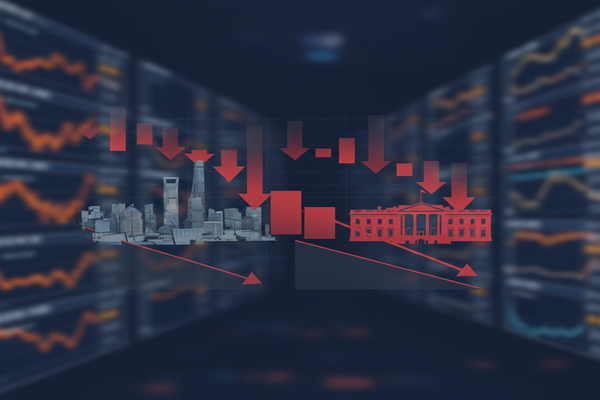
Markets spiral after Trump threatens new China tariffs. The president said Beijing’s tighter rare-earths controls and other trade moves could force new levies, and markets reacted sharply. Stocks fell, Treasury yields dropped, the dollar weakened and gold surged above $4,000 an ounce. This matters now because a tariff escalation can disrupt supply chains and raise inflation pressures in the near term while reshaping trade patterns over years. U.S. policy noise lifts volatility in Europe and Asia and rattles emerging markets that depend on Chinese demand. Traders should weigh the immediate liquidity shock against longer term implications for trade, technology and commodity sourcing, set against memories of past tariff rounds and the dotcom-era exuberance.
Market opening outlook
Why risk appetite is likely to test early on
U.S. equity futures are set to open under pressure after the weekend’s headlines. Investors reacted to the president’s comments about possible new tariffs and a canceled meeting with China’s leader by selling risk assets and rotating into traditional havens. This pulls forward short-term risk premia and raises the chance of choppy trading in the first hours of the session. Volatility that starts in New York can spill quickly to European and Asian markets because investors reassess exposure to trade sensitivity and global supply chains. Equities in technology and industrial sectors may feel the first impact because both areas have the most direct links to Chinese production and rare-earth inputs. However, trading patterns could flip if officials signal a path back to talks or if data releases reset expectations for growth and corporate earnings.
Fixed income and the dollar
Why yields are falling even as bond risks rise
Treasury yields fell after the tariff threat and a move lower in the dollar underlined demand for U.S. debt as a liquidity catch. Lower yields reflect a rush for safety and a short-term reassessment of growth prospects that can push investors toward duration. Meanwhile, the weaker dollar gives commodity prices more room to climb and provides relief to exporters outside the United States. Central bank watchers will track remarks from Fed officials closely. Fed Governor Neel Kashkari noted that artificial intelligence investments could raise borrowing needs for firms that build data centers and capacity. That comment complicates the policy outlook because heavy private capital spending can interact with central bank rate decisions. In the short term, markets will price risk from policy uncertainty. Over months, a sustained increase in corporate borrowing linked to AI projects could affect the term premium on longer dated bonds.
Commodities and safe havens
Why gold and raw materials look vulnerable to geopolitical whipsaw
Precious metals led the move to safety. Gold vaulted above $4,000 an ounce as traders sought protection from trade risk and currency swings. The jump shows how quickly safe havens can absorb flows when headlines point to supply chokepoints or sanctions in critical inputs like rare-earths. Raw materials sensitive to Chinese exports will need monitoring. If Beijing keeps tight export controls, producers that depend on those inputs will face higher costs and longer lead times. That outcome matters for manufacturers in the United States and Europe and for commodity importers in emerging markets. In addition, the interaction between trade policy and resource controls warns of a more fragmented sourcing environment over time, which could raise structural costs for sectors that rely on specialized minerals.
Policy and geopolitical risk
Why political moves are creating immediate market friction
The president’s phone call activity, tariff rhetoric and threats to cancel high level meetings drove much of the reaction. Political signals like that can trigger immediate repricing because they alter the probability of negotiated outcomes. This matters now because market participants had been expecting some stability in trade dialogue ahead of possible meetings. The threat to cancel talks with China increases uncertainty and can extend the time investors need to digest policy intentions. Historical parallels show that tariff shocks and trade standoffs can inflict sharp but uneven market shocks. Traders remember earlier tariff cycles that dented business confidence and supply chain planning. Meanwhile, broader geopolitical events such as conflicts in the Middle East and energy disruptions have already been testing risk tolerance. Combined, these factors raise the odds of episodic volatility and of differentiated performance across regions and sectors.
Sector focus and tactical considerations
Which segments are likely to lead and which to lag when markets reopen
Technology names that rely on specialized inputs and complex global supply chains could underperform on the open. Industrials and materials will be watched for earnings sensitivity to higher input prices and longer lead times. Defensive sectors such as utilities and consumer staples tend to fare better in headline driven drawdowns because cash flows are viewed as more predictable. Financial markets will also watch corporate funding needs if investment in AI data centers gains pace. That dynamic can lift issuance and affect credit spreads. Airline operators are already dealing with operational stress from federal workforce disruptions, which adds another risk for service sectors. Traders will parse company updates and government statements to separate transitory noise from signals that require repositioning.
Expect the first hours of trading to be dominated by headline reaction and liquidity management. However, follow through will depend on official clarifications, supply chain data and scheduled economic releases. Risk managers and market participants will be balancing immediate volatility with the possibility of a calmer path if talks resume. For global portfolios, the dual focus is on exposure to China linked revenues and sensitivity to commodity price swings. The session ahead will be a test of how quickly markets can price policy uncertainty and then revert to fundamentals once the noise fades.












